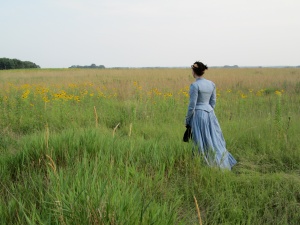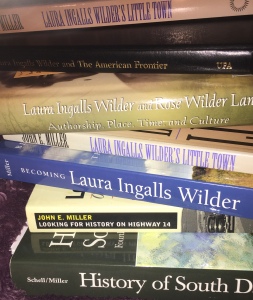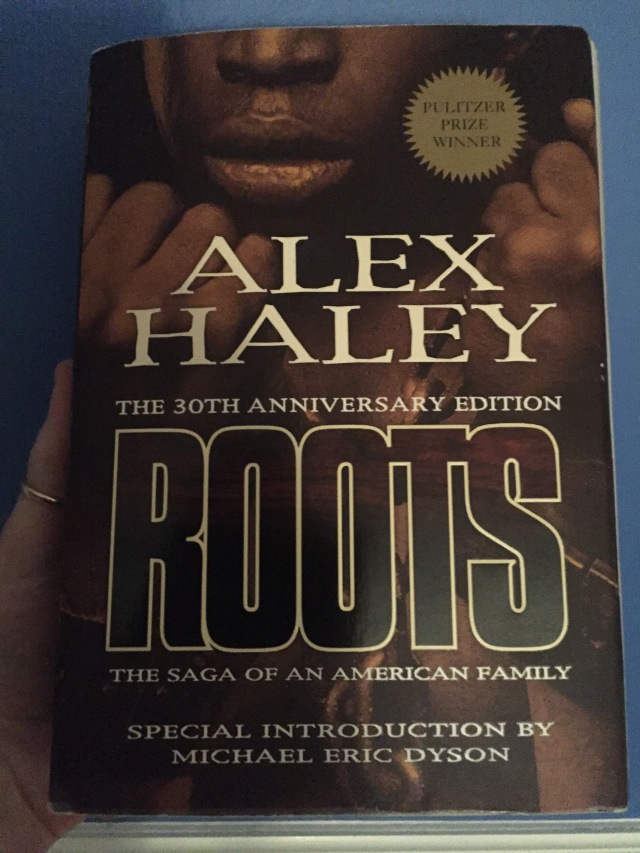
c. 1895 Visiting Suit, with modified “practical” sleeve. Photo by Connie R. Neumann, 2012.
What is “First-Person Historical Interpretation?”
Very often, when I meet someone and the subject turns to my primary occupation, I am asked what “First-Person Historical Interpretation” means. There are many variations in specifics, but, in general, it is the practice of taking a particular historic figure and learning absolutely everything one can about that individual, and then creating a live interpretation of that individual. These interpretations are complete with appropriate wardrobe, grooming, vernacular, and, of course, a thorough knowledge of the details of that person’s life, told from their own perspective.
If you can name any famous figure from the past, you can probably find one, a handful, or even a great many people who have studied that individual’s life and experiences extensively, and who can speak at length with some authority about that person. As with any other topic, some scholars are more experienced than others. Some scholars have researched and written volumes of work about their favorite person, while others have a more peripheral knowledge of the individual while retaining a great degree of contextual understanding; that is to say, their knowledge encompasses much of the wider world (region, culture, ethnicity, era, social and economic standing, or education level) in which that individual functioned. Some scholars can claim both! Some scholars speak from their own research as well as that of others. Some speak exclusively from their own work, some exclusively from the work of others. Some always take on the persona of their subject, while others always speak from a third-person perspective. Some scholars write a script for their presentations, while others work interactively and allow the audience to ask unlimited questions which direct the course of the program. Some toggle between the two approaches as the situation warrants.
Many scholars are rightly described by a combination of these features, having studied others’ work extensively while conducting their own research. Many of these scholars present in character almost exclusively, but adapt the program according to the ages, interest, and needs of their audience…and this is the best way to describe what I do.
So, what can I expect if I invite you to present a “visit” with Laura Ingalls Wilder at my event?
Expect:
~An interactive experience, wherein an adult “Laura” (a.k.a “Mrs. A.J. Wilder”) of the mid-1890s shares her experiences with the audience. This is the era when the Wilders have been married for about a decade, Rose is about 9 years old, and the family have settled on their new property, Rocky Ridge Farm, near Mansfield, Missouri.
~Research-based, factual information about Laura, Almanzo, Rose and their family and friends.
~Clarification of the differences between history and the fictionalized “Little House” series of books and other media interpretations.
~Abundant opportunities to ask ANY question you like of “Mrs. Wilder.”
~In-character answers which reflect Mrs. Wilder’s known activities, tastes, opinions, experiences, beliefs, and manners.
~”Mrs. Wilder” will be dressed in period-correct, authentic reproduction clothing, appropriate to Laura’s taste, means, activities and station in life, about 1895.
~An extensive display of relevant artifacts, including clothing, household items, books, and everyday objects, as well as some special “hands-on” items to investigate further.

This reticule is hand-made of black silk, with a pink silk/cotton blend lining and a 1-3/4″ pink silk edging inside the opening. The drawstrings are black silk petersham (aka “grosgrain”), and the design is a hand-painted wild roses motif. The outer dimensions of the reticule are approximately 9″ wide x 10″ high. I acquired it in Northwood, New Hampshire, in 2009. It is approximately 130 to 140 years old. Photo c. 2009 by Melanie C. Stringer.
What program topics do you offer? Will you customize a program for my group?
I have several topics from which you may choose, and I regularly design new programs to suit the needs of individual venues. If you have particular goals in your school curriculum, want to explore a topic related to your library or museum programming, or your private organization has a key interest in a particular aspect of Laura Ingalls Wilder’s life, work, and experience, I can accommodate you. Here are my three most popular programs:
Meet Laura Ingalls Wilder, LLC/Dakota Yankee Research
Program Descriptions*
~”A Yankee Woman is a Curiosity”
While “Up-North Gal” Laura may have grown up all over the west, her family is deeply rooted in their Yankee heritage, dating back to the 1620s in Massachusetts! As a married woman, Laura has lived as far south as the Florida panhandle and only recently moved to the Missouri Ozarks. Learn about the cultural differences and similarities between pioneers of the West, their folks “Back East,” and several places in-between.
~”Look How Far We’ve Come”
As the 19th Century draws to a close, Laura compares her experiences with a woman’s opportunities in the days of her Ingalls and Quiner grandmothers. Laura discusses the many advances women have made in just a few generations. As a mother, Laura observes women rapidly gaining more social freedom and political clout, including members of her own extended family. This prompts her to wonder, “What will the future hold for Rose?”
~”This Wonderful Modern Age”
Did you know that Laura followed the daily news very closely? Ask her about it! The Ingalls and Wilder family were voracious readers, and interested in gaining education throughout their lives. In this visit, Laura will offer a glimpse of the events and questions she finds most pressing in the Gilded Age of 1890s America.
*^*^*^*^*^*^*^*^*^*^*^*^*^*^*^*^*^*^*^*^*^*^*^*^*^*^*

Playing in the overgrown field on a balmy March morning…showing off the (reproduction) c.1896 Ulster coat, tailored of a navy herringbone pattern wool/cashmere. Photo copyright Gregory P. Stringer/Dakota Yankee Research, 2013.

Wading in the real Plum Creek of Laura’s childhood, on the former property of Charles Ingalls family. The outfit is a late 1880s calico everyday suit, black print on a brown field. The skirt is a gathered dirndle with ruffled overskirt. Photo by Chrissie H. Velaga, 2010.
What if I want you to do a different kind of Meet Laura program from what you list here?
This is just a partial list of available programs. If you would like a program tailored to your specific curriculum, group, or venue, please inquire. All requested topics considered. In the past, I have tailored programs for a wide diversity of groups, such as: a group of teachers who wanted Laura to help their 3rd-graders learn about overland migration and wagon travel, an antiquarian booksellers association interested in how I use period books to round out my research and enhance presentations, a community group that wanted to explore the Homestead Act and its impact on current land use, and a private organization which wanted to understand the Ingalls and Wilder connections with the Scottish Rite Free Masons and the Order of the Eastern Star. Don’t be shy–If you can think of a topic, I can relate it to Laura!
Please note: While every attempt is made to stick to the program topic of your choice, due to the highly interactive nature of the program, many presentations will include elements of all of the above descriptions, as well as other topics, according to the questions asked by audience members.
No matter what topic you choose, or how the audience questions tend, every Meet Laura Ingalls Wilder program offers a Research-Based, First-Person, Interactive History lesson to students and Wilder fans of all ages. All programs feature original research, hands-on artifact displays, period-authentic clothing and much more. Presentations are available year-round, across the United States and Canada.
What if I want something more general in nature?
I specialize in American Cultural and Social History, with a particular focus on Westward Migration, education, regional culture (especially New England, Upstate New York, and the Midwest), historic childrearing practices, and the occupations and opportunities of women and children in America from Settlement to ~1950. Additionally, I offer a tutorial of Victorian clothing, including the design, purpose, use and standards of proper dress in the late 1800s, from corset to collar. (Instruction in corset lacing at no extra charge!)
Tell me what you’d like to learn about, and I will design a program suited to you. I’m always up for a new challenge, and no event is too big, too small, nor too far away! For further information, or to inquire about booking a program, please contact me:
Melanie Stringer, Historian
Meet Laura Ingalls Wilder, LLC / Dakota Yankee Research
603-867-5320
info@meetlauraingallswilder.com

On the porch of the farmhouse, birthplace of Almanzo Wilder. The outfit is an 1891 visiting suit with high-waisted box-pleated skirt and close-sleeved basque. Photo copyright 2011, Melanie C. Stringer.











